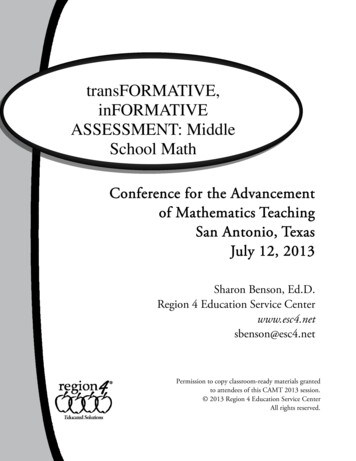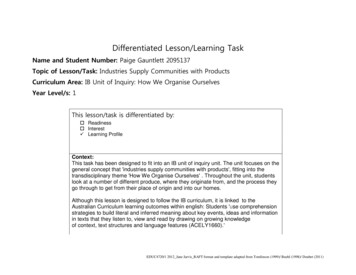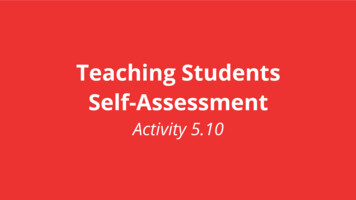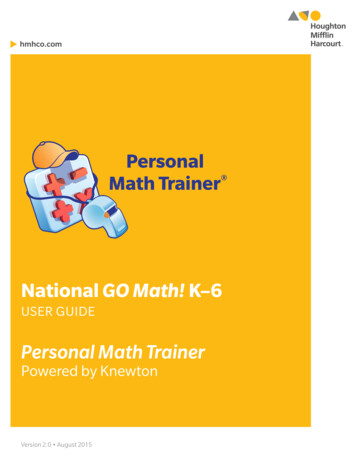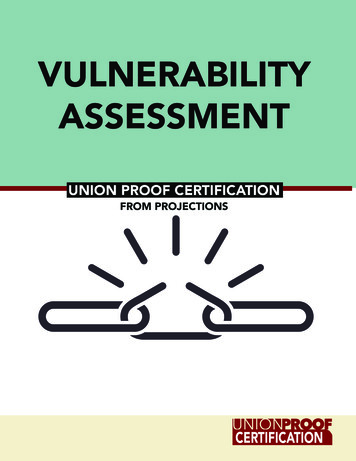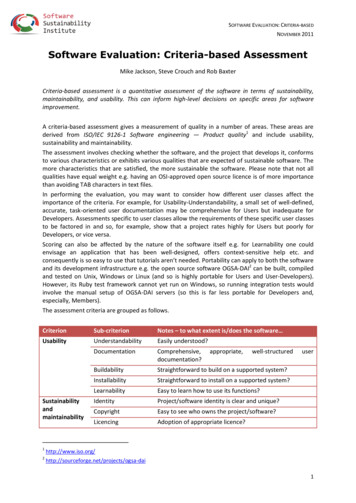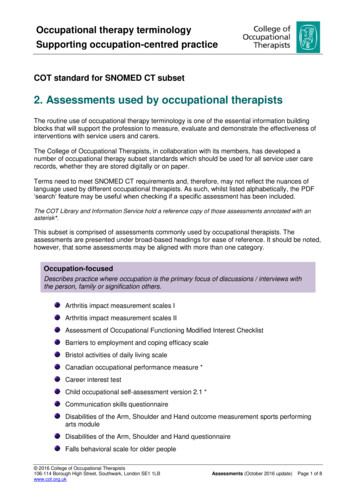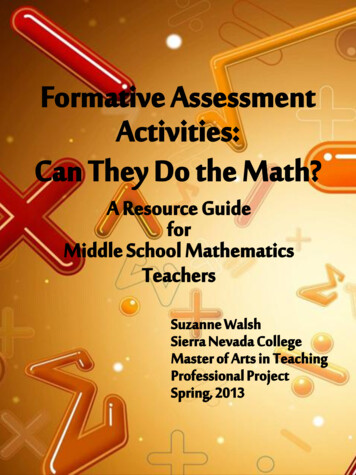
Transcription
Formative AssessmentActivities:Can They Do the Math?A Resource GuideforMiddle School MathematicsTeachersSuzanne WalshSierra Nevada CollegeMaster of Arts in TeachingProfessional ProjectSpring, 2013
This project is lovingly dedicated to Paul, Emily, Daniel,and Timothy. They helped me figure out what I reallywanted to be “when I grew up” and gave me the loveand support I needed to become a teacher.I would also like to acknowledge and thank DianeLancaster for showing up in my driveway one June day. Iwouldn’t have started this journey or been able tocomplete it without her!
Table of ContentsIntroduction Why Should Teachers Use Formative Assessments? Five Key Principles of Assessment in Action A Note to TeachersFormative Assessment Activities Multiple-Use Assessments3-2-1 Exit TicketsA-B-C SummaryAnalogy WritingClasswork TradeCreate Your Own Test QuestionsFingers on ChestFour CornersHomework Help BoardHomework PathwaysIn-Class Check-UpLearning LogsMonday QuizzesScale of 0 to 100Student Self-Report NoteThink-Pair-ShareThree-Minute PauseWhich Homework to Do?Formative Assessment Activities: Can They Do the Math?568911131415161718192021222425262729303
Table of Contents (continued) Content-Specific AssessmentsBefore and After – Mean, Median, Mode, and RangeCircles on the WallCombining Like Terms: I Have the Answer – What’s the Question?Transformations of Coordinate Pairs Floor GridUnit Rate Tables Using Individual WhiteboardsStandards MatrixBlack-Line Masters3-2-1 Exit TicketsStudent Self-Report NoteThink-Pair-Share Classroom ChecklistBefore and After: Mean, Median, Mode, and RangeMath Meeting Buddy SheetCoordinate Pairs CardsUnit Rate TablesReferencesAnnotationsFormative Assessment Activities: Can They Do the Math?323436373942454951535557596467694
IntroductionAs a Middle School Math teacher, I discovered that I use formativeassessments frequently in my classes in order to inform my teaching and providefeedback to my students. This resource guide will be a helpful tool for teachers,and not just in the mathematics classroom. The primary goal is to provide middleschool mathematics teachers with formative mathematic assessment activitiesand ideas on how to use and integrate them into their daily teaching practices.A secondary goal is to provide students with the opportunity toexpress their knowledge and showcase their critical thinking skills in an alternativeassessment format.Formative Assessment Activities: Can They Do the Math?5
Why should teachers useformative assessment?Public education in the United States today is largely motivated bystandardized testing. Students’ knowledge is evaluated on a yearly basis using amultiple-choice and open-response testing format, and the efficacy of the teachersis evaluated based on the results of those tests. Teachers in the classroom havefreedom with the types of assessments they use; but in my experience, I foundthat mathematics teachers seem to use multiple-choice tests more often thanother types of assessments.The exclusive use of standardized assessments in math can beproblematic because multiple-choice assessments do not provide teachers with awell-rounded measure of a student’s complete level of skill and ability. Bahr(2004) states that “traditional mathematics assessments tend to communicatethat mathematics is an endeavor that involves determining a quick answer using apre-existing, memorized method, thus failing to represent the true complexity ofmathematics” (p. 33).This suggests that standardized assessments are notmeeting the needs of teachers, and therefore alternative forms of assessmenthave a place in education in order to meet the needs of teachers for data they canuse to inform their lessons.Formative assessment (FA) is a method of assessment where studentsare given immediate feedback and furnished with ideas on how to improve whatthey are doing. The feedback must be useful to the student and according toJenkins (2010) be “specific, accurate, timely, clear, focused upon the attainable andexpressed in a way which will encourage a person to think” (p. 566) so they canmodify what they are doing, make corrections, and improve their learning. JenkinsFormative Assessment Activities: Can They Do the Math?6
also stated that “the effectiveness of [formative assessment] is reduced if studentsare not appropriately informed of what they are expected to demonstrate aknowledge of” (p. 567). In their research, Volante & Beckett (2011) stated that“formative strategies such as questioning techniques, feedback without grades,self-assessment, peer assessment, and formative use of summative assessmentscan double the speed of student learning” (p. 240). The use of FA in the classroomhas also been shown to reduce the achievement gap because FA strategies benefitlow achievers the most.Formative mathematics assessments can provide teachers with newinformation regarding the problem-solving skills and abilities of their students, andin turn inform teachers’ instruction (Bryant, 1996).Formative assessmentmethods also give students the opportunity to showcase their skills and abilities inless traditional ways.This project will be based on the five key principles of assessment inaction as outlined by Clark (2008) with the activities adapted to address all ofthese principles, in order to encourage dialogue and feedback between studentand teacher.Formative Assessment Activities: Can They Do the Math?7
1.Five Key Principlesof Assessment in Action*Students must be able to understand clearly what they are trying to learn,and what is expected of them.2.Students must be given feedback about the quality of their work and whatthey can do to make it better.3.Students must be given advice about how to go about makingimprovements.4.Students must be fully involved in deciding what needs to be done next.5.Students must be aware of who can give them help if they need it.*Clark, I. (2008). Assessment is for learning: Formative assessment and positivelearning interactions. Florida Journal of Educational Administration and Policy,2(1), 1-16.Formative Assessment Activities: Can They Do the Math?8
A Note to TeachersAs any teacher does, a math teacher experiences all levels of studentabilities and understanding of the content being taught in any given lesson in theclassroom. But math classes can move quickly from concept to concept,sometimes with little or no assessment until unit tests or chapter tests. This canleave a math teacher wondering if her students are learning the concepts beingtaught, and leave students wondering if they understand those concepts as well.Formative Assessment can be used in the math classroom to assessimmediate student comprehension and understanding of an entire lesson or just asmall part of it, and in some cases give you a chance to provide immediatefeedback to students. This Resource Guide contains a variety of FormativeAssessment activities that can be used in math classrooms in order to determineexactly which students learned the lesson, which students are a little shaky, andwhich students require additional support. Formative Assessment provides thestudents and the teacher with immediate feedback which can be used quickly toinform and adjust the lesson in order to provide an optimum learning experiencefor students. The times indicated for each assessment are estimates. Times varydepending on class size, teacher efficiency, and student engagement.The key to Formative Assessment is for teachers and students to learnfrom the information that is gathered and act on it. Formative Assessments shouldbe used in all classrooms regardless of content. The Formative Assessmentstrategies and activities that are compiled in this resource guide are divided intotwo categories: those that are content-specific and those that have multiple uses.The multiple-use activities can be adapted for almost any mathematics standard aswell as other content standards with only slight modifications or none whatsoeverin some cases.Formative Assessment Activities: Can They Do the Math?9
Multiple-UseActivities
3-2-1 Exit TicketOverview:An Exit Ticket is a tool that can be used by a teacher as a post-assessment of howwell the lesson went and what the students still don’t understand.Standard:Various – this is a multi-use strategyMaterials:3-2-1 Exit Ticket (see example and Black-Line Master)Time Needed: 25 minutes: 10 minutes to make and cut copies, and 15 minutes after classPreparation: The teacher must make copies of the Black-Line MasterInstructions: At the end of a lesson, give each student a 3-2-1 Exit Ticket. The students writethree responses to the sentence frames on the Exit Ticket as follows: 3 things I learned today . 2 things I found interesting . 1 question I still have .The teacher collects the Exit Tickets as the students leave the classroom after the lesson. Theteacher reviews the exit tickets and makes notes of what content may need to be reviewed orre-taught depending on the students’ answers.Variations:Alternative sentence frames can be substituted on the exit ticket depending on what the teacherwould like to know about the lesson and the students’ level of comprehension. For example: 3 things I learned today . 2 ways I can apply this information . 1 thing I did not understand .-OR 3 things I can teach my classmate . 2 things I am really excited about . 1 thing I am still not sure of .Formative Assessment Activities: Can They Do the Math?11
Examples:321Things I Learned Today .321Things I Can Teach My Classmate .Things I Found Interesting .Question I Still Have .Things I Am Really Excited About .Thing I Am Still Not Sure Of .Formative Assessment Activities: Can They Do the Math?12
A-B-C SummaryOverview:This is a quick, creative, fun assessment teachers can use to determine levels ofcomprehension of their students and allowing students to share their ideas with one another.Standard:Various – this is a multi-use strategyMaterials:NoneTime Needed: 10 minutesPreparation: NoneInstructions: At the end of a lesson, each student is assigned a different letter of the alphabet.Teachers can use their own discretion and leave letters out or duplicate letters for larger classes.Each student must select a word starting with that letter that is related to the topic beingstudied.As a whole class, the students will share their words and the logic of why they chose them. Theteacher can write the words on the board in alphabetical order to create a comprehensive list ofwords linked to the topic.Note: In order to avoid certain letters of the alphabet or assign letters more creatively, teacherscan use abstract choices. For example: The third letter of the student’s last name The second letter of a parent’s name Every letter in a mathematical sentenceExtension:Students create a mini-poster (8-1/2x11 maximum) for their vocabulary word, including adefinition and picture, for the classroom word wall.Formative Assessment Activities: Can They Do the Math?13
Analogy WritingOverview:Assess your students’ understanding of concepts with analogies. Provide aprompt which will allow students to reflect on what they have learned.Standard:Various – this is a multi-use strategyMaterials:NoneTime Needed: 5 minutesPreparation: NoneInstructions: Periodically throughout your lessons, present students with an analogy promptfor a designated concept, principle, or process. Allow the students time to reflect and then havethem read their analogies aloud to the rest of the class.Sentence frame analogy prompts:“The(concept)is likebecause.”“The most important thing aboutis(concept)because.”Formative Assessment Activities: Can They Do the Math?14
Classwork TradeOverview:Students use peer assessment to assist each other in making sure their classworkis complete and correct before turning it in to the teacher.Standard:Various – this is a multi-use strategyMaterials:Colored pencilsTime Needed: 10 minutesPreparation: NoneInstructions: At the end of a lesson, or shortly before, students find a partner and tradeclasswork (this can be a notebook, writing paper, worksheet, or anything else that has beenassigned to be finished in class that day). The students read each other’s work and check tomake sure that all components are included. The students make notations using differentcolored pencils, provide positive feedback using accountable talk, and then return it. Eachstudent adds anything that was missing before it is turned in to the teacher.Formative Assessment Activities: Can They Do the Math?15
Create Your Own Test QuestionsOverview:Students get excited when they help you with test questions because they feellike they have inside information! This fun formative assessment activity can be used to evaluatetotal student comprehension of the content and provide students with their own study guide.Standard:Various – this is a multi-use strategyMaterials:NoneTime Needed: 10-15 minutesPreparation: NoneInstructions: Teachers ask students to prepare math problems to help create a summativeassessment of the content being taught. Students create any number of problems the teacherrequires, modeled after their homework or class work, in order to create their own study guide.The students must solve the problems and return them to their teachers for evaluation.Based on the quality of responses from the students, teachers may choose to use the problemsfor a quiz, an in-class game or contest, or to create a summative assessment. Regardless of howthe student-generated problems are used, teachers should be sure to integrate them into thecurriculum so students get a chance to see their work!Formative Assessment Activities: Can They Do the Math?16
Fingers on ChestOverview:For a quick assessment of how students feel they are comprehending a lesson,use this activity which allows students to keep their reflection private.Standard:Various – this is a multi-use strategyMaterials:NoneTime Needed: 5 minutesPreparation: NoneInstructions: Ask students to reflect on their level of comprehension of the lesson presented byplacing fingers on their chests for only the teacher to see. Use a scale of one to four, with onebeing lowest level of understanding and four being highest. Teachers assess the studentresponses quickly and then decide whether to revisit the content or move forward.Formative Assessment Activities: Can They Do the Math?17
Four CornersOverview:After teaching a lesson, allow students to move to different corners of the roomdepending on their level of understanding of the lesson being taught. The students in eachcorner generate questions they have and report them to the class for discussion.Standard:Various – this is a multi-use strategyMaterials:Labels for each cornerTime Needed: 10-15 minutesPreparation: The teacher must establish this routine at the beginning of the year by teachingthe students what each corner represents in their level of learning. The corners should belabeled, “Stop!” “Slow Down” “Keep Moving” and “Let Me Help”. These labels can be left up allyear long.Instructions: Call for “Four Corners” in order to assess the level of student comprehension of alesson. The students go to the corner of the room that best fits their level of understanding ofthe lesson.Corner 1 “Stop!” – I am totally confused.Corner 2 “Slow Down” – I understand some of it but couldn’t pass a test todayCorner 3 “Keep Moving” – I’m getting it and I wish we wouldn’t have too muchhomework about it.Corner 4 “Let Me Help” – I understand it and could teach it to my friends.Once students go to their corners, they have two minutes to generate questions with the otherstudents in that corner about what they are learning. The questions are then asked to the classfor clarification and discussion. The questions generally reflect the level of understanding fromeach corner, and the teacher can quickly address gaps and incorrect learning.Formative Assessment Activities: Can They Do the Math?18
Homework Help BoardOverview:Start your class using this day-after-homework routine and use it as a quickassessment to determine whether students had difficulty with the homework. Teachers canassess student work immediately and reteach if necessary based on homework problemsstudents write on the board.Standard:Various – this is a multi-use strategyMaterials:White board, dry erase markersTime Needed: 5-10 minutes during a warm-up activityPreparation: NoneInstructions: At the beginning of class, students review their homework and identify anyproblems that they didn’t understand or caused them difficulty. The students write thoseproblem numbers on the board. Students who had no difficulty and successfully completed theproblem write the solution on the board for the class to see. If a student had a differentapproach to solving a problem, that student can add their solution to the board as well.Once the solutions are on the board, the teacher uses questioning strategies in order to facilitatea student discussion. If all the problems have been solved correctly, the teacher moves on to thedaily lesson or possibly asks one or two questions as verification that all students understood theconcept. If problems were solved with different approaches, the teacher can review the variousmethods and ask the students to discuss them. If a problem noted on the board has no solution,the teacher can review that problem, suggest a first step, and provide scaffolding in order toreteach the concept to the class.Variation: Use different pens for boys and girls. Boys do not always show their work, and girlsuse only the method taught to find solutions. Require boys to do the problems first and show allwork. When the boys are finished, ask girls to provide alternative ways of solving the problems.Formative Assessment Activities: Can They Do the Math?19
Homework PathwaysOverview:Allow students the opportunity to choose a “Homework Pathway.” This willreduce student frustration and lessens the need to reteach students who have learned andpracticed a concept incorrectly.Standard:Various – this is a multi-use strategyMaterials:NoneTime Needed: None (this homework policy is established at the beginning of the year)Preparation: The teacher must establish this homework policy at the beginning of the year.Instructions: When homework is assigned, students can choose which pathway they shouldfollow according to their individual level of understanding of the lesson.Pathway 1:If students are confident after finishing their homework that most or all of theiranswers are correct and they understand the concepts, they generate three questions they feelthe teacher should use on the summative assessment.Pathway 2:If students completed their homework but are not certain they have all thequestions right, they should try three to five more problems to see if they can figure it out withthe additional practice.Pathway 3:If students are frustrated and confused after attempting to do their homework,they should stop answering the questions and instead create a list of their own questions theycan ask the teacher the next day to help them understand the concepts.Formative Assessment Activities: Can They Do the Math?20
In-Class Check-UpOverview:This activity is used the day before a test or quiz. The teacher can assess thecomprehension of the students and provide them with guidance on what areas to concentrateon as they study.Standard:Various – this is a multi-use strategyMaterials:Paper and pencilTime Needed: 65-70 minutes: 20 minutes to prepare review problems and a worksheet, and 4550 minutes in classPreparation: The teacher must prepare 5-6 review problems for the students to complete inclass and a review worksheet for the students to take home as homework. The teacher mustalso teach the students how to answer the review problems on notebook paper so the teachercan assess them quickly during the class.Instructions: The teacher provides the students with 5-6 review problems on the board inpreparation for a quiz or test the next day. As students work to complete them, they must writethe answers down the left side of the paper in order for the teacher to be able to assess theanswers quickly in class. Student work is shown on the right side of the paper. When studentsare finished with the review problems they raise their hand so the teacher can evaluate theirwork. The students will rework any problems that are incorrect.If the problems are all correct, the students are given the review worksheet to begin in class andfinish as homework. In this way the teacher can give the students immediate feedback onconcepts they are having trouble with and guide them in what they need to study in order to beprepared for the quiz or test the next day. To ensure that every student’s work gets checked, theteacher keeps a list of names to check off and monitor.Formative Assessment Activities: Can They Do the Math?21
Learning LogsOverview:Students use Learning Logs to help integrate content, process, and personalfeelings. Learning Logs can also become a vehicle for exchange among parents, teachers, andstudents.Standard:Various – this is a multi-use strategyMaterials:Notebook or composition book for each studentTime Needed: 5 minutes at the end of a class; additional time for assessment conferencesPreparation: NoneInstructions: At the end of a lesson, students are given five minutes to reflect on their learningby writing in their Learning Log. Logs can include problem-solving entries, observations,questions about lectures, word problems they have created, predictions before a concept istaught, definitions of key vocabulary, justification of a solution to a problem, summaries of theday’s lesson, comments about homework assignments, and reflection on the student’s ownunderstanding and the questions that may still exist.The teacher can guide the students in their writing until they get used to it by asking open-endedquestions: What did I do in class today? What did I learn? What did I find interesting? What questions do I have about what I learned? What was the point of today’s lesson? What connections did I make to previous ideas and lessons?These topics can help teachers identify strengths and weaknesses in their students’understanding of math content and address individual needs. Short assessment conferences arescheduled throughout a week or at the end of a unit to discuss the reflections and providefeedback to students. Teachers can also assess students in cooperative groups, thus reducing thetime required for conferences.Formative Assessment Activities: Can They Do the Math?22
Variation:Students can write in their Learning Logs on a weekly basis, reflecting on what was learnedduring the week: what they found challenging, what their accomplishments were, and otherthoughts and ideas regarding the week’s lessons.Alternative Sentence Stems: For students who need more support using the English language,teachers should provide sentence stems.“Today in class, we learned about.”“In this lesson, I found“I am confused aboutinteresting.”because.”“I can use what I learned in class today when I.”“I am proud that I understand how to.”Formative Assessment Activities: Can They Do the Math?23
Monday* QuizzesOverview:Give a short pre-assessment to your students on Monday aimed at the learningtargets of the week in order to differentiate instruction for the week. This is an excellentformative assessment strategy for a team of teachers.Standard:Various – this is a multi-use strategyMaterials:White board or overhead projector, sticky notesTime Needed: 65-70 minutes; 5-10 minutes on Monday (or the first class day of the week)during each class, and 60 minutes that same afternoon to review data and prepare lessonsPreparation: The teacher must create a short pre-assessment which will provide informationabout student knowledge of what will be taught that week.Instructions: On Monday at the beginning of class, display the problems on the overheadprojector or whiteboard and provide time for the students to solve them. Students record theiranswers on sticky notes with their names on them, which they give to the teacher. At the end ofthe day, the sticky notes are sorted into three categories: student clearly understands concept;student doesn’t understand concept, or it remains unclear whether student understandsconcept. The teacher then creates three different learning activities based on each group ofstudents. The students are grouped by ability and the teacher supports each group during theclass.Variation:A team of teachers can work together to lighten the workload. All teachers givethe pre-assessment and review their data. After the review process, each teacher can design onelearning activity so the work is shared. The students can remain in their classrooms with theirown teacher. As an alternative, the students can be moved into different classrooms dependingon ability, with one teacher taking each group. The teachers meet at the end of each day forreview and problem-solving techniques to help the students in their room who are notmastering the content. In this case the teachers need to be able to work together and beorganized so that each teacher has a list of the students they will be teaching in their classroom.*First class day of the weekFormative Assessment Activities: Can They Do the Math?24
Scale of 0 to 100Overview:Using a scale of 0 to 100, students analyze their own level of comprehensionbefore a content unit. Afterwards, the students re-evaluate and compare where they started andwhere they ended.Standard:Various – this is a multi-use strategyMaterials:Chart paper or a large piece of butcher paper, 1x3 sticky notes in two colorsTime Needed: 30 minutes: 10 minutes of preparation, 5 minutes at the beginning of the unit,and 15 minutes at the endPreparation: Teachers must make a chart which will be used as a bar graph with an x-axis goingacross the bottom and a y-axis going up the side. The x-axis should be labeled in tens starting at0 and going up to 100. The paper can be labeled with the content title and should be left up inthe classroom until the end of the unit.Instructions: Before the beginning of the unit, teachers ask students to evaluate their level ofknowledge of the content on a scale of 0 to 100. Students place their blank sticky note on thegraph paper according to how much they think they know about the content (students do notput their names on the sticky notes). Placing it above the 0 shows no knowledge of the content whatsoever Placing it on the 100 shows complete knowledge with no teaching necessaryThe sticky notes are placed above each other on the paper, creating a bar moving up from thenumber the students choose.After the unit is finished, teachers revisit the graph and ask the students to re-evaluate theirlevel of knowledge. The teachers give students a different-colored sticky note and they place iton the graph again, reflecting their new level of knowledge. The students and teachers canvisually see the increase in the level of knowledge of the class as a whole.Note: If teachers want specific information regarding individual students, the students writetheir names on the back of the sticky notes for privacy.Formative Assessment Activities: Can They Do the Math?25
Student Self-Report NoteOverview:Students attach a “Student Self-Report Note” to their homework or otherassignment, reflecting on their own level of learning, and passing that information on to theteacher.Standard:Various – this is a multi-use strategyMaterials:NoneTime Needed: 20 minutes: 10 minutes to make and cut copies; 10 minutes to assess dataPreparation: Copies of “Student Self-Report Notes” must be made and cut (see example andBlack-Line Master)Instructions: Teachers hand out copies of the “Student Self-Report Note” to each student whenan assignment is given. After completing the assignment, students check off a box on the notedepending on their level of comprehension of the assignment, and explain their choice. Teacherscollect the notes along with the assignment and assess the data. Teachers reteach as necessary.Example:Student Self-Report NoteWhile doing this assignment, I felt (check one):[ ] confident that I knew how to do all the problems. I think I knowthe material well enough to teach others how to do the work.[ ] like I knew how to do some of the problems but not all of them.Explain[ ] like I thought I knew how to do the problems when I started, butthen I got confused and lost.Explain[ ] lost from the beginning. When the teacher was explaining how todo the problems, I did not understand.ExplainFormative Assessment Activities: Can They Do the Math?26
Think-Pair-ShareOverview:Students are given time to think individually about a lesson or concept, discuss itin pairs with a partner, and finally, share it with the teacher and class for a quick formativeassessment.Standard:Various – this is a multi-use strategyMaterials:NoneTime Needed: 5 minutesPreparation: NoneInstructions: Whenever a quick formative assessment is necessary to evaluate student levels ofcomprehension, ask students to Think-Pair-Share. The students spend two minutes thinkingindividually about the lesson, writing a few notes for themselves if necessary. When time is up,students turn to a partner (someone next to, in front of, or behind them) and discuss theirthoughts with each other. The teacher must ensure that all students have a partner. When theallotted pair discussion time is over, the students participate in a full-class discussion. Theteacher listens and takes notes as necessary during the pairs and full-class discussions to assessthe different student levels of comprehension. Teachers can use a spreadsheet with a learningscale (See example and Black-Line Master) to make notes of what level of understanding eachstudent is at.Note: While students are discussing the lesson in pairs, keep them on task by requiring them torepor
classroom. But math classes can move quickly from concept to concept, sometimes with little or no assessment until unit tests or chapter tests. This can leave a math teacher wondering if her students are learning the concepts being taught, and leave stud
